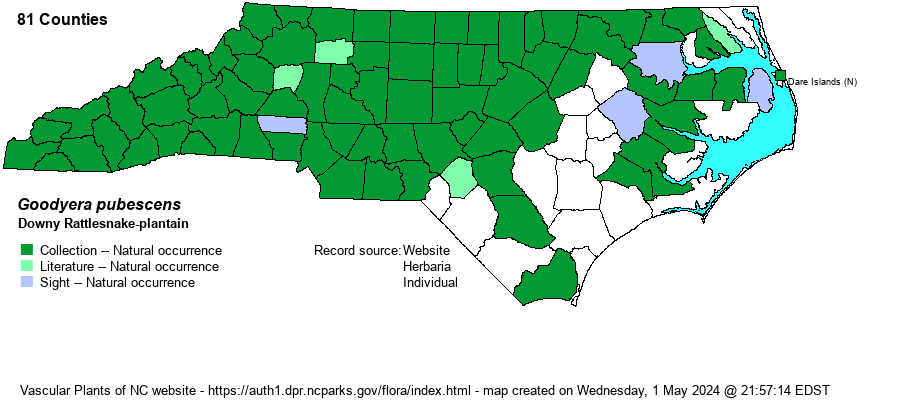| Author | (Willdenow) R. Brown | |
| Distribution | Throughout the Mountains and Piedmont; in the Coastal Plain found across most of the northern half, but of spotty occurrence in the southern half, and presumed absent in some southern coastal counties.
This is a widespread Eastern species, ranging from eastern Canada south to the FL Panhandle and MS; it is absent from LA and TX. | |
| Abundance | Common and widespread across the Mountains and Piedmont. Fairly common to common along the northwestern and western Coastal Plain, and uncommon in the Sandhills. However, uncommon and local in the rest of the Coastal Plain, and perhaps absent in the far southeastern counties. This species and the Cranefly Orchid (Tipularia discolor) are, by far, the most frequently seen orchids in the state. | |
| Habitat | This orchid has as wide a habitat range as any in the state, being found in most forests, from rather rich to dry, though not in overly sandy sites. It can be found in bottomlands as well as in uplands, and often is found under a pine canopy as much as under hardwoods. |
| Phenology | Blooms from June to August, and fruits shortly after flowering. | |
| Identification | This species is much easier to spot in winter than in summer, as it has basal, evergreen leaves that are patterned with white. Each plant has several basal leaves, each ellipitical, entire, bluish-green, with a wide white central stripe and a fine network of smaller white veins. Each leaf is only 1-2 inches long, but the cluster is easily seen by persons walking in forests at all seasons, but more so in winter. In midsummer, the plant sends up a flowering stalk averaging 1 foot tall, and the stalk contains several dozen small, white, ball-shaped flowers growing very close to the top third of the stalk (on all sides of the stalk). You do not need to examine the flowers unless you want to; they are quite small, and the basal leaves alone are enough for identification. The somewhat similar Lesser Rattlesnake-plantain (G. repens) is a scarce species of the mountains, with a smaller cluster of basal leaves, each with much wider white side veins and with a rather secund (flowering on one side of a stem) inflorescence. As many people limit their forest interior walks in midsummer or late summer, owing to heat, mosquitoes, and other factors, the inflorescences are often not seen by observers. | |
| Taxonomic Comments | None
| |
| Other Common Name(s) | Weakley (2018) and a few other references use Downy Rattlesnake-orchid. This is a better name, as the species is, obviously, an orchid, and not a plantain (genus Plantago). However, nearly all other references use "Rattlesnake-plantain", including NatureServe. And, "Rattlesnake-plantain" does not really imply a plant is a plantain! | |
| State Rank | S5 | |
| Global Rank | G5 | |
| State Status | | |
| US Status | | |
| USACE-agcp | UPL link |
| USACE-emp | FACU link |

